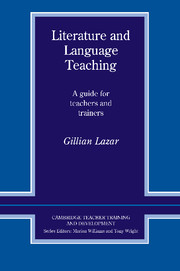Book contents
- Frontmatter
- Contents
- Thanks
- Acknowledgements
- Introduction
- 1 Using literature in the language classroom: The issues
- 2 Approaches to using literature with the language learner
- 3 Selecting and evaluating materials
- 4 Reading literature cross-culturally
- 5 Materials design and lesson planning: Novels and short stories
- 6 Materials design and lesson planning: Poetry
- 7 Materials design and lesson planning: Plays
- 8 Reflecting on the literature lesson
- 9 Literature and self-access
- Answer key
- Trainer's notes
- Bibliography
- Appendix: Eveline by James Joyce
- Index
3 - Selecting and evaluating materials
Published online by Cambridge University Press: 04 May 2010
- Frontmatter
- Contents
- Thanks
- Acknowledgements
- Introduction
- 1 Using literature in the language classroom: The issues
- 2 Approaches to using literature with the language learner
- 3 Selecting and evaluating materials
- 4 Reading literature cross-culturally
- 5 Materials design and lesson planning: Novels and short stories
- 6 Materials design and lesson planning: Poetry
- 7 Materials design and lesson planning: Plays
- 8 Reflecting on the literature lesson
- 9 Literature and self-access
- Answer key
- Trainer's notes
- Bibliography
- Appendix: Eveline by James Joyce
- Index
Summary
In Chapter 2 we considered different approaches to using literature with the language learner, and in Section 2.1 we discussed whether it was appropriate to use literature with particular groups of learners. In this chapter we focus more specifically on how to select texts and materials which are suitable for use with your students. Of course, you may not have a choice of either texts or materials. Perhaps you are bound by a syllabus which sets out what literary texts you have to use with your students even though you can design the tasks to exploit these texts yourself. Or the syllabus may lay down both the texts and the exercises and tasks needed to exploit them. If you do have some choice in the selection of texts and materials, then Section 3.1 will help to pinpoint some criteria for selecting literary texts to use with your learners, while Section 3.2 suggests ways of evaluating published materials.
Selecting texts
In choosing a literary text for use with your students, you should think about three main areas. These are: the type of course you are teaching, the type of students who are doing the course and certain factors connected with the text itself. We begin by thinking about the first of these – the type of course you are teaching.
Task 1
Think about a group of students you have taught in the past, are teaching at the moment, or are going to teach in the future. Note down the information about them which is listed in the boxes opposite.
- Type
- Chapter
- Information
- Literature and Language TeachingA Guide for Teachers and Trainers, pp. 48 - 61Publisher: Cambridge University PressPrint publication year: 1993

